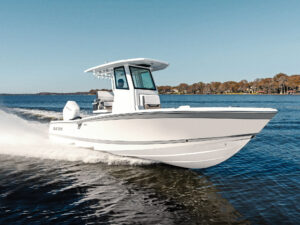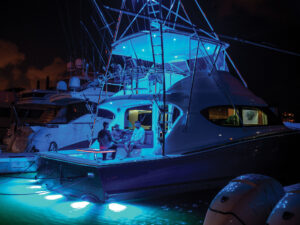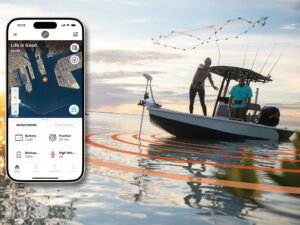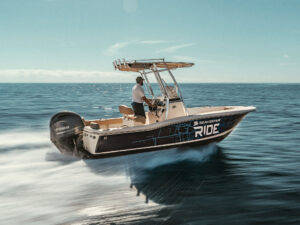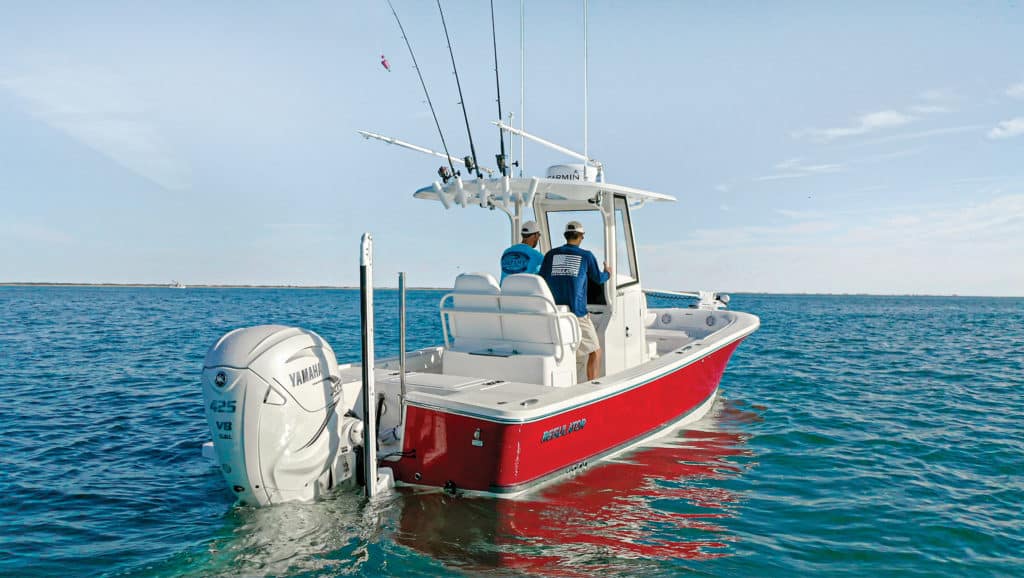
“If you can dream it, you can do it. That’s the way we used to look at it when all we had was a 17-foot Aquasport,” says Michael Currey, regional manager for Skeeter Boats. “And we made it work for everything we wanted to do. Then they invented the flats boat, and then the bay boat, and we were into an evolution.”
That evolution includes designs with the capability to handle a variety of fishing styles, such as hunting inshore shallows and offshore blue water. The range of models in modern bay-boat evolution represents not so much a particular identifiable design but rather a spectrum of possibilities.
At one end of the spectrum lies the mission-specific boat for inshore waters: low gunwales, casting platforms fore and aft, and shallow draft but still eats up chop. On the other end, the offshore-oriented hybrid or crossover retains the features that make the bay boat utilitarian while incorporating elements more familiar on an offshore center-console.
In the world of boat design, the compromise cliché has traditionally been baked in, but in no category of fishing boats is “compromise” so minimized as on the bay-hybrid spectrum.
Do It All
Versatility is certainly the bench mark in the broad popularity of this class of fishing boat. In addition to adaptability that ranges from flounder fishing along the shoreline to nearshore reefs and beyond, the functionality and safety features make the bay-hybrid class a comfortable adapter among fishing demands, family-and-friends cruising, and just hanging out.
“Our heritage is in fishing, and we never want to compromise with those features.”
Shelley Tubaugh, Grady-White Boats
“Customers for our crossover 251 CE represent 10 percent hardcore fishermen; 10 percent who use the boat for family and cruising and don’t fish at all; and everybody else, who does both,” says Shelley Tubaugh, vice president of marketing for Grady-White Boats.
Even among dedicated anglers, versatility has its appeal in both function and economics.
“As the price of boats has gone up, anglers responded by looking for a boat that does more than one thing,” says Keith Ammons, VP of sales and marketing for Regulator Marine. “In the past, someone would have had a 28 offshore and a 16- or 18-foot inshore boat. Now they are looking for boats that truly cross over.”
As well as appealing to anglers who know what they are looking for, the category represents a perfect entry point for first buyers.
“First-time buyers may not have the experience to know if they will be fishing 90 percent of the time or hanging out, so they need a boat they can learn from and figure out what they want to do,” Ammons says.
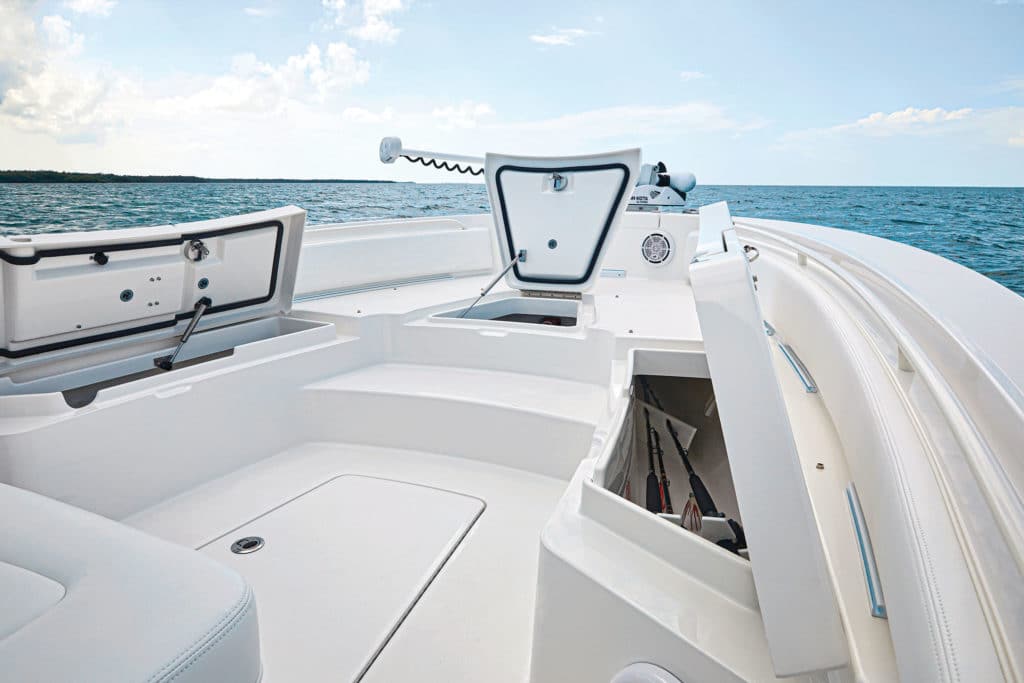
Comfort and Utility
In a hybrid destined to do family as well as fishing duties, higher gunwales and coaming bolsters go a long way toward comfort and safety, especially when children are part of the crew.
Typically, the hull combines the best qualities of an offshore deep-V and a float-in-dew flats skiff, meeting somewhere in the middle.
“Our hybrids are wide, and while maybe not the ideal offshore boat for everyone, the bow has a chop-eating Carolina flair,” Currey says. “We meet the needs of anglers who ride the razor’s edge to float shallow and handle bigger water.”
“Creativity in design is essential. Boats have to be a Swiss Army knife, and we have adapted to that.”
Michael Currey, Skeeter
That combination of sea handling and shallow-water operation lies at the heart of the hybrid hull design. “Even on inshore waters, it can blow up in the afternoon, and you can be facing 3- to 4-footers. That’s when a hybrid design is nice,” says Christian Carraway, product-design engineer for Grady-White Boats. “For that reason, in our 251 CE, we have retained the SeaV2 hull of our offshore models, with a flatter deadrise toward the transom.”
Interior layout steps up to a higher standard in a hybrid.
Foremost is seating. Die-hard anglers may be content to get by with a grab rail, but multiple-use buyers look to assure comfort on nonfishing days.
“Secure, safe seating you can settle into is important to buyers,” Currey says. “Prospective buyers pay a lot of attention to the arrangement of the seating, comfort and security. I see buyers snuggling in, seeing how it feels. Seating is very important.”
Hand in hand with seating goes modularization. Even in a 26-foot boat, space must be dual-purpose, and what is fishing and fighting space on a Saturday likely needs to be a comfortable social area, complete with a table, on Sunday.
“In our [Skeeter] 2550, our model—the table in the bow, the seating, the fishing deck—is all convertible. And we can drop the forward step down for tarpon fishing or to accommodate kids and older people,” Currey says.
“Our legacy is fishing, so we never sacrifice those features in our boats,” Tubaugh says. “But what we really see is a combination use, because it is so easily converted between fishing and cruising.”
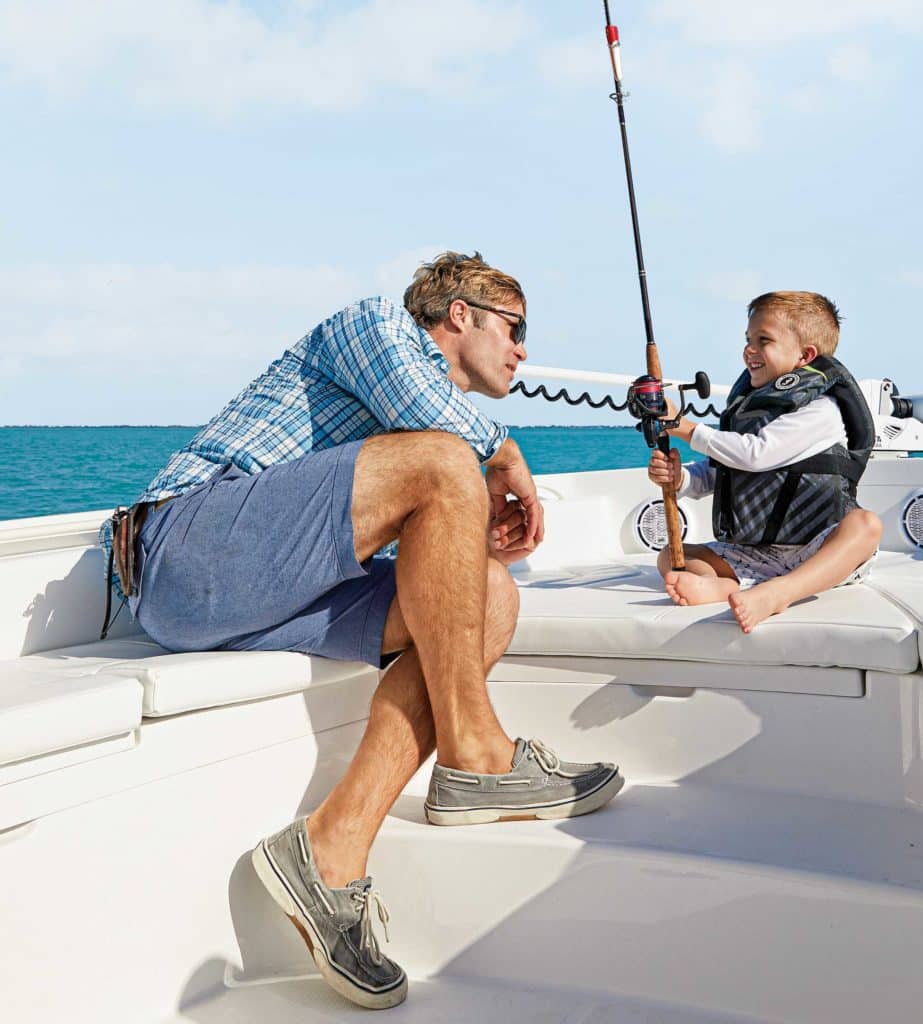
Never Enough
When it comes to storage on any boat, experienced anglers know—and new buyers learn—that there never seems to be enough.
“However the storage is arranged, ‘the more the better’ is a good rule thumb,” Ammons says. “You want as much as you can get.”
Access hatches to systems is never going to be easy enough, and should be as efficient and frustration-free as possible.
As well as abundant, storage should be efficient. Hatches for storage should be placed where they are most useful. Fish boxes should be easy to load in the heat of action, in either the casting decks in smaller boats or the cockpit sole in larger boats for mid- and offshore fishing. Any removable cushions should fit in nearby compartments so transformation remains easy and quick.
Well-designed and properly placed hatches are not limited to places to put stuff. They also come into play when regular system maintenance or repairs are required, or when accessorization is in order. Access hatches to systems (such as pumps, filters, and batteries and electrical components) should be large enough to work through easily and well-placed, to allow both regular maintenance and troubleshooting when needed—without requiring contortions or uncomfortable working positions. “Hatch access is very important, and buyers should be looking for that,” Ammons says.
“Regulator’s identity is building the best offshore center-console boats. We build fishing boats—that is our key.”
Keith Ammons, Regulator
Check for an access plate over the fuel-tank sender, a common maintenance point. The little things don’t matter until they do, then they matter a lot. Consider the long horizon of your ownership of that boat. Look 15 years down the road: Can you access the fuel tank, should it need to be replaced, without cutting up the deck? The best boats are built with an eye to the future.
Hatches, especially those that lie flat in the sole or on the casting desks, should be guttered to drain water that makes its way onto the deck. Errant waves and rainstorms aside, this is a day-to-day consideration as well, when it comes to washdown and cleanup. Hatch lids should be gasketed to close with a tight, rattle-free seal, which also keeps everything inside dry. Lids should be well-supported or engineered to stay open on their own to allow two-handed loading and unloading. Heavy hatches may need gas rams for support when opened.
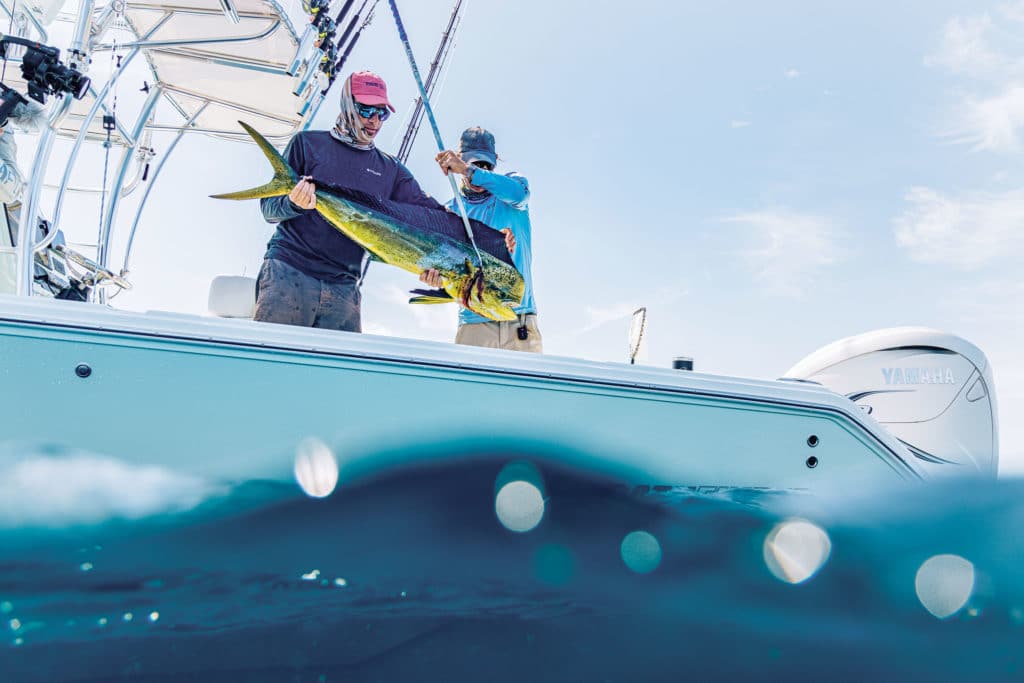
Waterworks
Livewells become a highly personal matter for serious anglers. Options may even be dependent on the where the builder finds their primary market, or where you ultimately buy the boat.
“Our [Skeeter] 2550 comes standard with a 50-gallon livewell in the leaning post,” Currey says. “In South Florida, anglers always appreciate that, but in Alabama and along the Gulf Coast—where it’s mostly a dead-bait or jig fishery—they’d rather have a cooler.”
Another consideration is a head in the console compartment. A marine head system has its own maintenance demands, so as a prospective buyer, you should decide if it’s worth it.
“Everybody wants a head in the console when they are shopping,” one builder remarked. “Most of them will use it just once. After the first time, they are through with it.”
In any size boat, keeping the water out is the No. 1 job of any plumbing system, which includes overboard drainage. Self-bailing cockpits should be sufficiently guttered to drain water quickly and thoroughly through scuppers that exit the hull above the waterline when the boat is loaded and at rest. Belowdecks, check through-hull fittings. They should be as robust as possible, and bronze is the preferred material for critical fittings.
All drainage lines should run straight, without sags, and all connections should be double-clamped for a margin of security.
Editor’s Tip: Whether your fishing requires nothing more than a crustacean well (to carry live shrimp or crabs and keep them lively and healthy for inshore pursuits) or demands a high-capacity or multiwell sea-chest-supplied system (for intensive live-baiting and chumming offshore or over reefs and wrecks), the time to make sure you have the system and setup you need is before you buy—so with the first launch, you’re ready to fish.
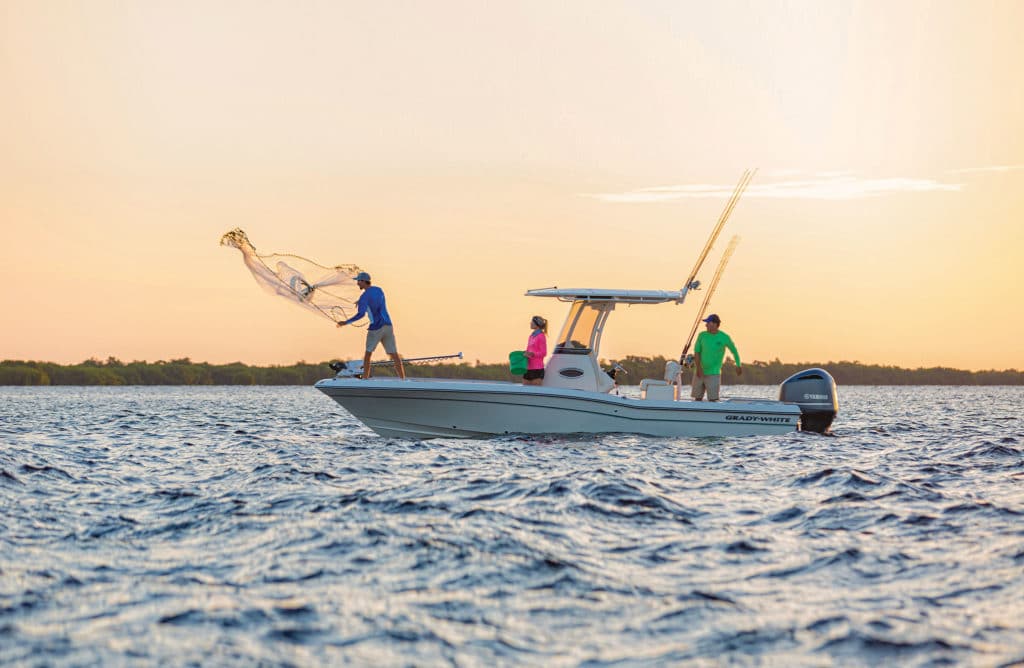
Tech Considerations
Marine electronics are a veritable candy store for boat buyers and, as such, demand a realistic assessment of your genuine needs.
Some manufacturers include an electronics package in the original build, while others leave it up to the buyer.
Grady-White leaves the electronics suite to the buyer and dealer.
“Some of our dealers prefer particular brands,” Tubaugh says. “As well, each coastal area has its own little tweaks when it comes to the preferred electronics. We make sure they have plenty of space to work with.”
Skeeter, on the other hand, takes an active role in supplying electronics.
Case in point: “We offer dual transducers in our hulls: one transom mount for side and one through-hull for deep water,” Currey says.
Other than regional preferences, the size of the boat and the type of duty demanded of it are the best guidelines for wise choices in an electronics suite.
“We see a mix of products installed, based on how people will use their boat,” Ammons says.
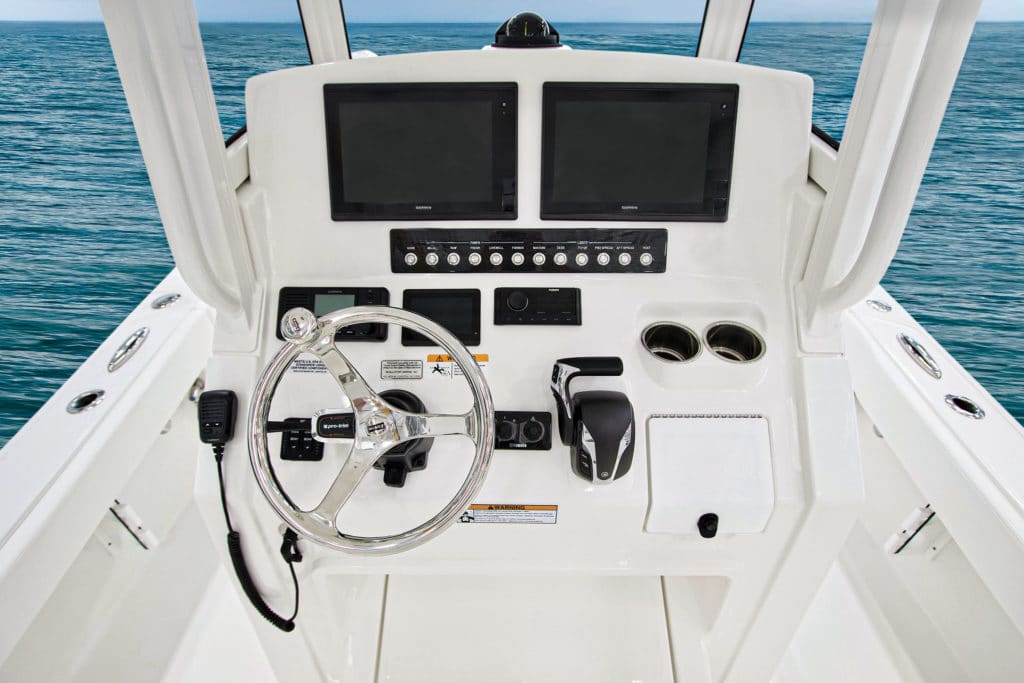
If you are fishing or cruising mostly inshore, don’t probably don’t need radar. And for the chart plotter and sounder, a single screen may be enough. Offshore, you might want VHF radio or an autopilot; the things you would seldom see and rarely need inshore.
Bridging the categories of electronics and fishing accessories, anchoring systems—such as Talon or Power-Pole—and trolling motors go hand in hand in most bay boats and some hybrids.
Trolling motors now often include a GPS link, which allows you to follow a predetermined course or depth contour, or hold in place, with a push-button anchoring function.
Functionality is often integrated with the suite at the helm.
“Younger buyers expect instantaneous action,” Ammons says. “It’s the way we are on our computers, on mobile devices, and there’s no reason to expect any less from our boats.”
Again, it’s important to select and install these accessories based on how you’ll use your boat.
“We mount our trolling motor on a slide,” Currey says, “which allows you to pull the head and the gear case inside the outline of the hull, which prevents it from getting beat up when docking or tied up when you go to a restaurant.”
In lieu of a factory installation, an important consideration is a boat ready to have the accessories installed.
“For trolling-motor and anchoring systems, we supply a prep package—prewired and supplied with mounts—then let the dealer make the installation,” Tubaugh says.
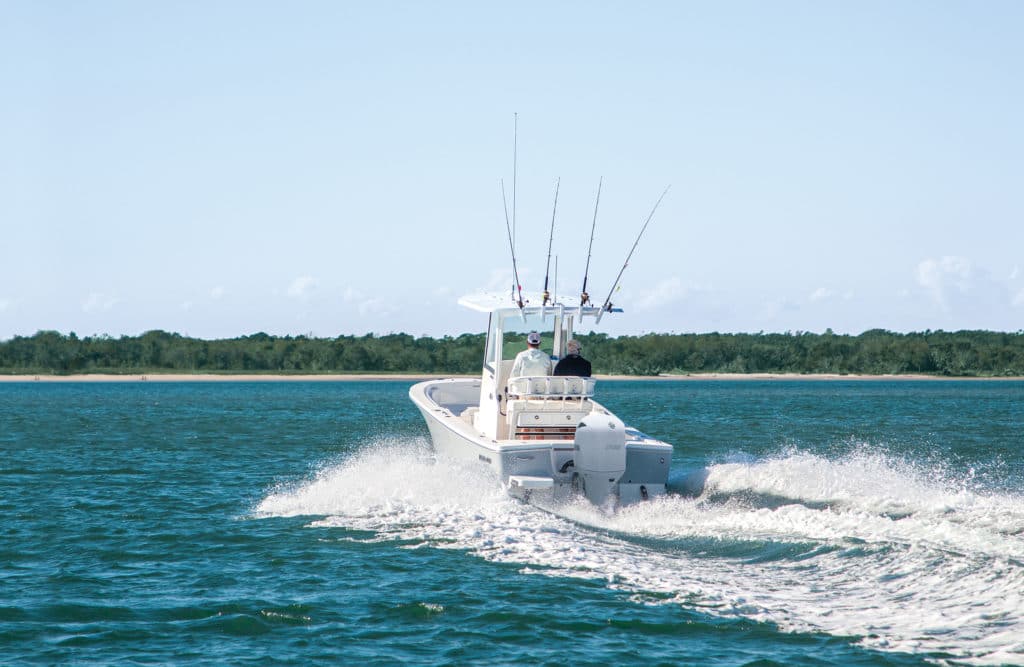
Get Up and Go
The original bay-boat configuration featured a single outboard, but not all builders conform. Especially in offshore-oriented hybrids, twin outboards are not unusual.
Long passed are the days when a second engine was a necessary backup. Reliability is seldom an issue, but twice the maintenance may be a deterrent.
“We’re accustomed to putting the most amount of fuel capacity possible in our bay boats,” Currey says. “We know the customers for those—just like our bass-boat customers—are anglers, and they are going to burn fuel.”
Grady-White is well-attuned to the fuel needs, Tubaugh says. “Our 251 CE carries 78 gallons of fuel. That’s not a small tank. All of our fuel considerations are in line with our offshore models.”
Editor’s Tip: Newcomers to boating, as well as experienced, discerning hands, find the bay-boat model an ideal choice. In 2019, first-time outboard-boat buyers represented 9 percent of total outboard-boat sales. In 2020, that number rose to 22 percent, a 144 percent increase, according to the National Marine Manufacturers Association.
Bay-Boat Quality Checklist
This 10-point checklist is a good start on quality. If they have these points right, what you can’t see is likely also done well.
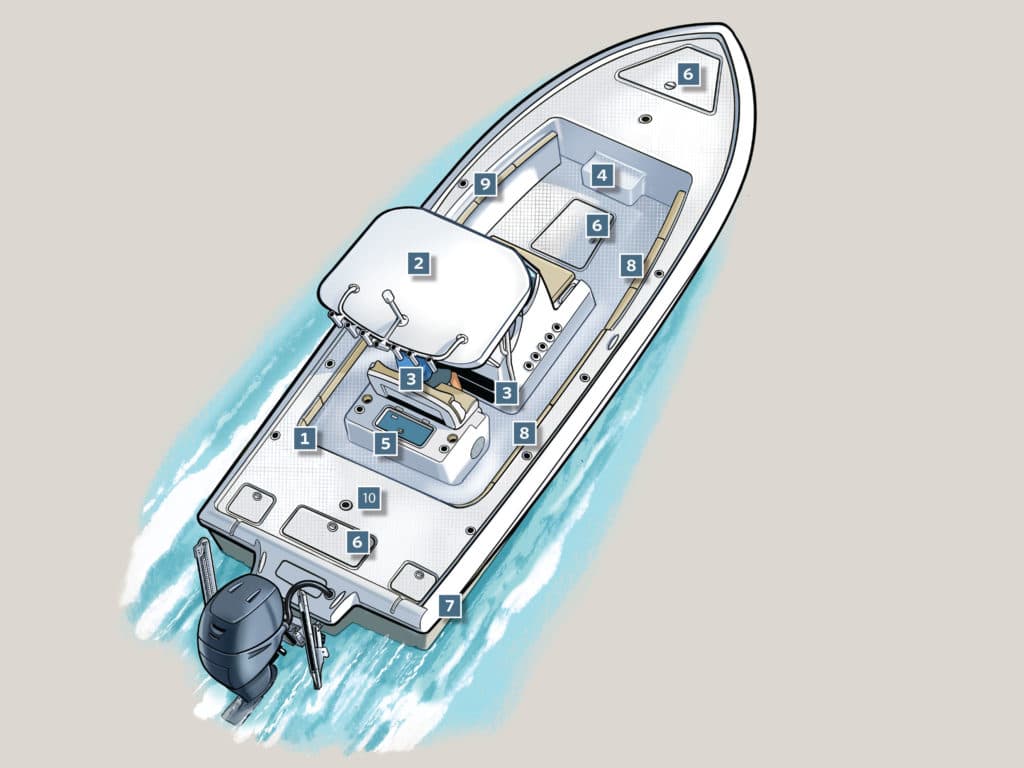
1. Scuppers are positioned in lowest points on the sole and well above the water line, so water doesn’t back flow into the boat.
2. Wiring is logical and easy to trace, and wires are labeled at each end within 6 inches of the terminals.
3. Helm station wide enough to offer protection for two behind the windshield
4. Steps to the forward deck ease access and knee strain.
5. Livewells have redundant pumps, strainers and seacocks that can be easily shut off in an emergency.
6. All hatch lids are gasketed and guttered to keep water out of compartments. Gutters drain overboard, not to the bilge.
7. Deck plates give access to fuel-tank sending units for needed service, tanks are beneath removable deck panels for future replacement.
8. Decks molded with diamond-plate nonskid are superior to other surfaces.
9. Rub rails should have stainless-steel rims for durability and utility.
10. Cup holders and casting-deck-chair sockets should be plumbed to drain overboard or to the deck, not the bilge.

